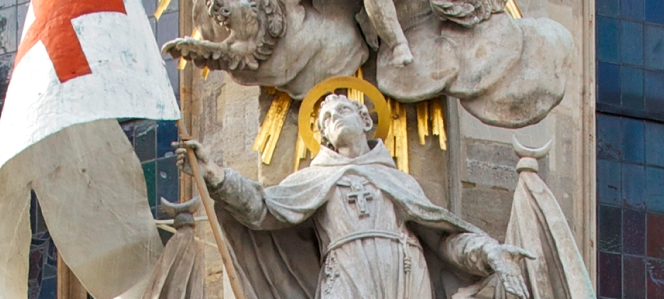In 1976, October 23 was assigned by Pope Paul VI as the date the Church would remember the life and witness of Saint John Capistrano.
Saint John Capistrano died on this day in the year 1456.
John was a Franciscan friar and priest, but not of the good-natured variety of Franciscans that holds the popular imagination. To describe John as zealous would be an understatement. He walked the fine line between zeal and fanaticism, allowing God to write straight with the crooked lines he drew throughout his life.
His chosen profession was a lawyer. He was a married man. He set aside his profession and left his wife, actions that were the result of an intense experience of conversion. He entered the Franciscan Order and became well known for his preaching and teaching. He led a reform of the Franciscan Order that insisted on radical asceticism and obedience. He brokered no compromise and had no patience for opposition. Appointed as an inquisitor, his prosecution of heresy was ferocious.
Ironically, this hunter of heretics found himself accused of heresy, but he successfully defended himself against these accusations and was acquitted of the charges.
He died during the siege of the city of Belgrade in the year on October 23, 1456. He is known as a “soldier saint” because he personally led troops into this battle.
Saint John of Capistrano was a heroic figure and his life well represents the age in which he lived. Those warlike days seem over for us, and it is likely some might say that his life has little, if any resonance or relevance, to our own concerns. Most nowadays recoil in horror at a Church that would insist that heresy be prosecuted in civil courts and priests take up arms in battle. This sense of revulsion has not always been the prevailing norm.
We share the same Faith as Saint John Capistrano, but our vision of what the Faith should be and do differs in some, if not many, respects.
Some might wonder why such a man is even a saint, but he is, and the lesson in that might be that being a saint is about more than just being nice and friendly. Sanctity is an uncanny quality that can be as off-putting as it is attractive.
We might be “put off” by a saint like John Capistrano. Perhaps the lesson there is that if he made it, there is hope for us all.
Saint John Capistrano is known less for his mighty deeds than for the migratory habits of the American cliff swallow that for centuries returned to nest at the California mission church named in his honor.
The swallows returned to the ruins of the San Juan Capistrano mission church on March 19th every year, and their fidelity was recalled in story and song.We might see in the swallows of Capistrano an image of the Church, whose institutions endure over time and serve the purpose of drawing us again and again into the life of Christ’s sacramental grace. The number of swallows returning has lessened over the years as development in the area surrounding the mission has given the birds alternative sites to nest. The birds have found other homes.
There might be a lesson, a kind of parable for us in this. The Church’s institutions are necessary and good, but they cannot, in themselves sustain the mission Christ has given us over time. Being a Christian demands much more than just maintaining or matriculating through institutions. A pristine building that is themed Catholic in its décor and supported by endowments, but does little or nothing to bring people to Christ, teach the Faith, or inspire works of mercy might attract some interest for a time, but people will inevitably look elsewhere for Christ if they do not seem to find him under our roofs.
Christ is not, after all, a monument, but a living, divine person and the Church is not an institution but the extension of his divine life and presence in the world.
We are not Christians because we build and maintain institutions. We are Christians because people experience in us an invitation to know Jesus Christ and find in his Church the reality of his divine life and presence.
If this is not the case, our institutions will find themselves as bereft of the faithful as the old mission church of Capistrano is empty of the swallows that used to flock there and make it their home.
